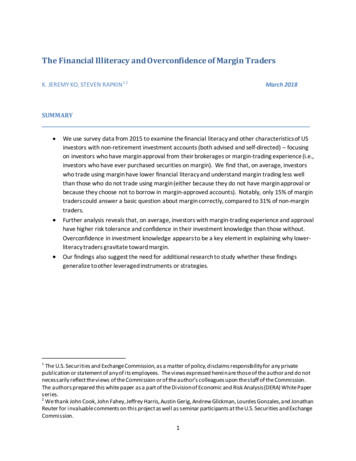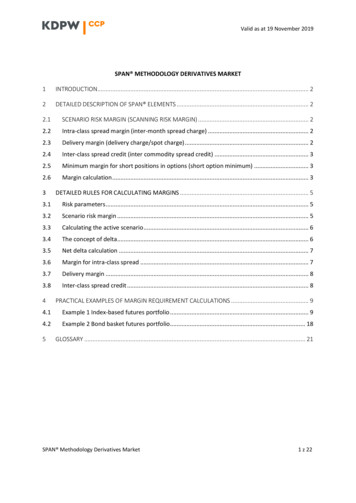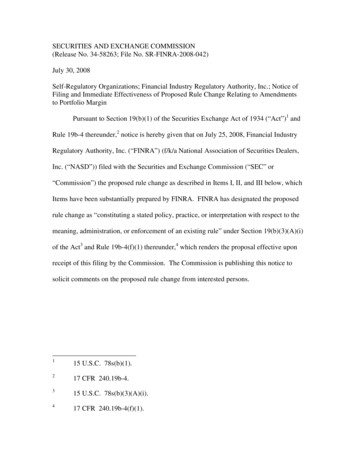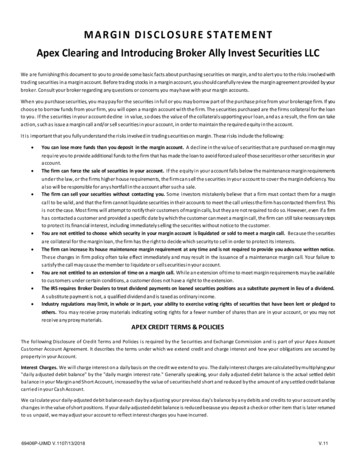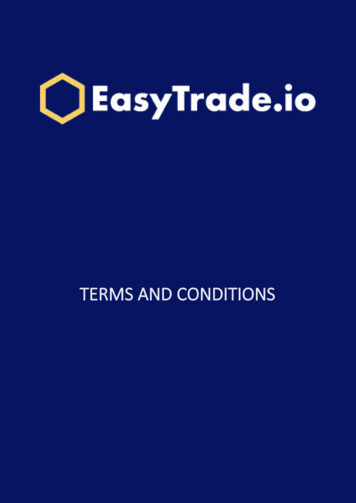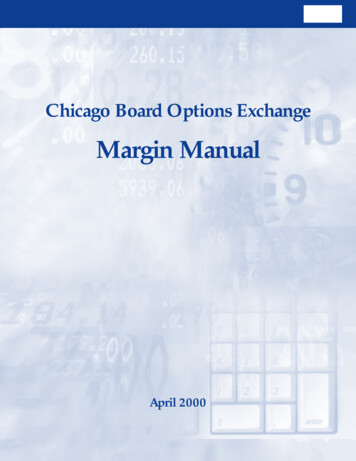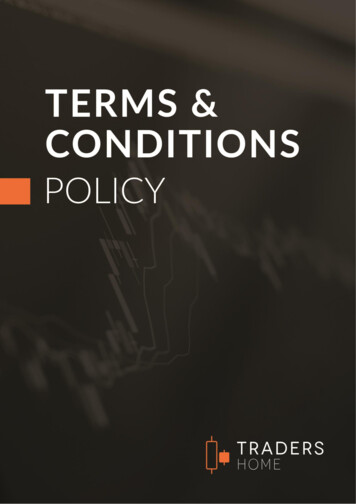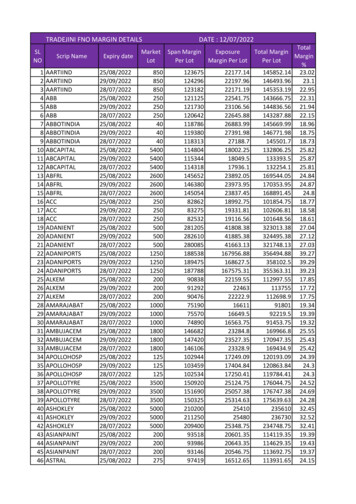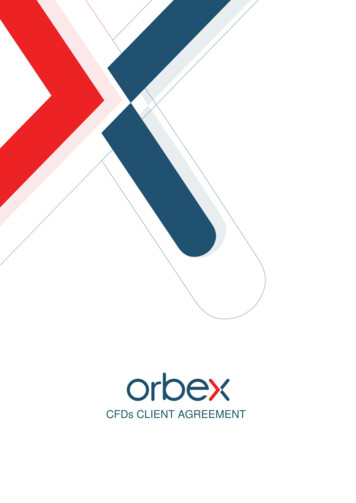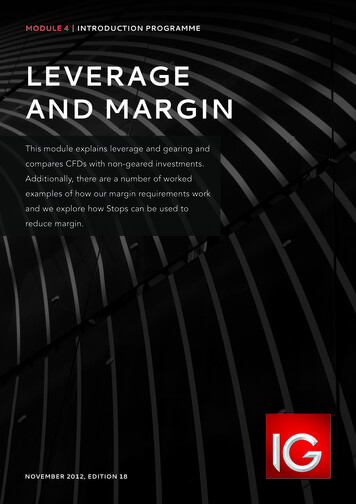
Transcription
MODULE 4 INTRODUCTION PROGRAMMEMODULE 4LEVERAGEAND MARGINThis module explains leverage and gearing andcompares CFDs with non-geared investments.Additionally, there are a number of workedexamples of how our margin requirements workand we explore how Stops can be used toreduce margin.NOVEMBER 2012, EDITION 18
MODULE 4CONTENTS3LEVERAGE AND MARGIN7MARGIN8 EXAMPLE 1: GOING LONG GERMANY30 WITH LIMITED RISK10INITIAL MARGIN14 VARIATION MARGIN15 MARGIN REQUIREMENTS WHEN USINGNON-GUARANTEED STOPS2LEVERAGE AND MARGIN
MODULE 4LEVERAGE AND MARGINLEVERAGE& MARGINIf you were to buy shares, through a stockbroker or any other traditional sharedealing service, you would have to pay the full purchase price of the shares.For example, let’s say that you decided to purchase 2000 shares of HSBC at a priceof 5.91. Ignoring commission, you would have to pay 2000 x 5.91 11,820 inorder to make the purchase – in other words, the full value of the shares.With CFDs this is not the case: you do not have to put up the full value of theunderlying shares (or the underlying value of whichever instrument you aretaking an exposure to; this doesn’t only apply to trading with Share CFDs).Instead, you typically put up only a small portion of the underlying value. Thisis known as the initial margin (sometimes also referred to as deposit).In the case of HSBC, the deposit required is just 5%. This is the initial margin fora selection of the more liquid stocks from around the world, including more than50 UK shares. Most FTSE 100 and FTSE 250 shares require a deposit of 10%,while less liquid or more volatile shares may require higher deposits.*So for the same value of HSBC shares, if you were doing the deal as a CFDinstead, you would only need to put up 5% x 11,820 591 as a deposit.TO REITERATE:*Subject to the total size of your trades on aWith the physical share deal you take ownership of 2000 shares and pay 11,820.given share being below a certain (substantial)size. We margin higher rates once the total size ofUsing CFD trading you take a position of equivalent size and deposit 591.Both deals offer you exactly the same exposure: if HSBC goes up by 1p, bothdeals make you 20 (the 2000 shares are worth 1p more:2000 x 1p 20).CONTINUED3your position for a given share exceeds a certainthreshold. HSBC is margined at 5% provided yourtotal size is smaller than 190,000 shares. In otherwords, this tiered system of margining tends toaffect those dealing in very large sizes only. Moredetails can be found on our website.
MODULE 4LEVERAGE& MARGINCFD trading is geared: it offers a greater exposure for the amount ofmoney that you invest. To put it another way: gearing allows you tocontrol, for a low outlay, a much more expensive asset.Gearing has the effect of magnifying profits and losses. This is betterillustrated by continuing with the example to see how the profit or loss of theposition, relative to the initial outlay, is affected by movements in the shareprice. Throughout the example, commission and spread will be ignored forsimplicity’s sake.SCENARIO 1: HSBC GOES UPLet’s say that HSBC rises in price, as you had hoped, and you decide to takeyour profit, selling at 6.44, after a net rise of 53p. With the physical holding,you dispose of your 2000 shares, receiving 6.44 for each share that you sell.The proceeds from the sale are therefore 2000 x 6.44 12,880.The shares cost you 11,820 in the first place, so you have realised a profit of 12,880 - 11,820 1060.Expressed as a percentage of your initial investment this is: 1060/ 11,820 x 100 8.97%. While this is a solid return, it’s notparticularly spectacular.Let’s compare this with CFD trading. A 53p gain for a trade equivalent to2000 shares equals a profit of 0.53 x 2000 1060, the same amount ofprofit in absolute terms as the physical purchase. When we consider this as apercentage of the amount of money that was required to place the CFD trade,however, the difference is marked.The deposit required was 591. 1060/ 591 x 100 179.36%.When the profits are considered as a percentage of the outlay, the CFD tradeoffers returns that are vastly greater than the ungeared physical investment.CONTINUED4LEVERAGE AND MARGIN
MODULE 4LEVERAGE& MARGINSCENARIO 2: HSBC FALLS IN PRICELet’s say that you don’t grab your profit as in the first scenario, but insteaddecide to hold your position. The share price gives back its gains little by little,until eventually the position moves into the red. After it has gone 22p againstyou, you decide that you have had enough and cut your losses. You sell out toclose your position.The amount of loss for both types of trade is 440 (2000 shares x 0.22/share).This represents a loss of 3.7% on your investment placed through thestockbroker ( 440/ 11,820) but a much larger 74.5% loss of the deposit placedfor the CFD trade.This effect, whereby losses and gains are effectively magnified relative to theamount of money that you have outlaid, is also known as leverage.So, is CFD trading more risky than buying and selling shares in theconventional manner?From a certain perspective, the answer is yes.In scenario 2 above, had you been gearing up beyond your means, using allyour disposable income as the deposit, you would undoubtedly have beentaking a significant risk.CONTINUED5LEVERAGE AND MARGIN
MODULE 4LEVERAGE& MARGINIt should be pointed out, however, that both trades in the examples above –the physical investment and the trade placed through our CFD service – hadexactly the same exposure. The ultimate downside for both was 11,820.Neither trade could lose more than that amount. The CFD trade simplyrequired a smaller outlay in order to achieve that exposure. From this point ofview, you could argue that the trade using our CFD service was no more riskythan the conventional share trade.If you were to compare the exposure that you could take through ourinvestment service for a 591 deposit (this would give you a trade equivalentto 2000 shares) with buying 591’s-worth of shares, however, the CFD tradewould be more risky. In this setting there is no comparison. Using our CFDservice in this incidence gives you a trade 20 times larger, owing to theleverage bestowed by the 5% deposit requirement.For this reason you should always make sure that you are fully aware of howmuch your total underlying exposure is. With most CFD trades your potentiallosses are not restricted to the deposit you have put down.6LEVERAGE AND MARGIN
MODULE 4MARGINBecause it is possible to accrue losses that exceed the amount you havedeposited with us, when a position moves against you we may oftenhave to ask you to send us more money. This is more properly known asvariation margin, but is often simply referred to as margin.Before we move further into discussing such issues as when and how muchmoney needs to be sent as margin, let’s first consider the case of trades thatsidestep this issue.You can only be asked for margin on positions for which your deposit doesnot cover the total risk. That is to say, there are certain types of trade for whichthere is a set limit on your risk; as long as you have deposited enough tocover that risk, it follows that you cannot be margined any further. Specifically,these are trades for which a Limited Risk premium has been paid or any longcontract on an option (an option is a type of derivative. We offer CFDs ona wide range of options and you can find more information on our websitewww.igmarkets.co.uk).So, if you are only ever placing Limited Risk trades or ‘buying’ options, life issimple: whenever you place a trade it will require a certain deposit, which isequal to the maximum loss possible on that trade. As long as you have thatamount on your account, you will never be asked to send further funds to coverthe risk on the position, even in the worst case scenario (it should be pointedout that dividend payments for short positions and any funding costs will incurdebits to your balance; these may require you to further fund your account ifyou have deposited only enough to just cover the trading risk of the positions).Let’s look at a quick example of a trade with Limited Risk protection,in order to illustrate this point.7LEVERAGE AND MARGIN
MODULE 4EXAMPLE 1LEVERAGE AND MARGINLONG GERMANY30 WITH LIMITED RISKThe DAX is near recent lows at 5949.5 and you think the index looks likea good buy from a technical point of view. You make up your mind totake a long position, but are wary of the fact that the trend has generallybeen in the other direction of late, and therefore don’t want to commityourself too heavily. A trade with Limited Risk protection seems like agood way to profit from the value in the market that you see withoutfacing too much risk if you’ve got it all wrong.Our Germany 30 is a stock index CFD that allows you to speculate on theperformance of the leading stocks in Germany (and can be nominated to expireat the end of the day at the closing level of the DAX). Our quote for Germany30 is 5949/5950 and you decide to buy one contract. One contract of Germany30 has the value of 25 per point movement in the level of the market.The premium charged for taking a Limited Risk position with the Germany30 is 3 points. This is the extra value you pay in order to receive the addedbenefit of a Guaranteed Stop (we do not charge commission for stock indexcontracts: all the charge is in our dealing spread).You open your trade at 5953 (the offer of 5950 plus the Limited Risk premiumof 3), placing your Guaranteed Stop 40 points away at 5913. Your maximumrisk is 1000 – that’s guaranteed – but there is no ceiling on your profit. Thisway, if the market drops 200 points you’ll only lose your 1000, but if it moves200 points the other way you stand to make several times that.The deposit required for the trade is equal to the risk: 1000. You havepreviously transferred over 1000 into your account so that now – unless youmove your Stop further away – you cannot be margined further, as your 1000covers everything (ignoring any dividend adjustments, which would causedebits to be made to the balance of your account).CONTINUED8
MODULE 4LEVERAGE AND MARGINLONG GERMANY30 WITH LIMITED RISKOver the next few weeks, the downward trend of the markets in general –including the DAX – continues. Eventually our Germany 30 price sails throughyour Stop, quickly establishing new lows at 5650. Your position is closed atyour Stop level and you lose the 1000 that you deposited.As we saw in Module 3, as well as Limited Risk trades which have GuaranteedStops, we also offer trading with Stops which are not guaranteed. The situationis a little bit more complicated for a position which has a non-guaranteed Stop.The basic information is that the margin required is larger than the margin thatwould be required if you were using a Guaranteed Stop. The maximum possibleloss is not restricted to the initial margin, although you will not be asked forvariation margin whilst the trade is open (provided the Stop is close enough toreduce the margin requirement below the amount that would be required if theposition had no Stop). How we calculate the margin required for deals placedwith non-guaranteed Stops is looked at in more detail after the next section inthis module.9
MODULE 4INITIAL MARGINWe have looked at trades where you won’t be asked for funds beyondyour initial margin. Let’s now focus on all the other types of deal, for whichyou put up an initial deposit representing only a portion of your total risk.We have touched on the margin requirements for trading shares, which are aset percentage (dependent on which share you are dealing) of the underlyingvalue. Usually this margin percentage varies from 5% to 50%, but for veryilliquid shares, or special cases such as unusually large deals, the percentagemay be higher (such incidences are extremely rare).FX, Spot Gold and Spot Silver also work in this way: the normal MarginPercentage for an FX transaction is 2% of the position value, with 3% thepercentage for Gold and 5% for Silver (some of our more popular FX pairs aremargined at just 1%*).Other types of trade generally work in a slightly different manner in which wespecify a margin requirement per contract.Margin requirements are determined by the volatility of the market in question,as well as by the amounts that exchanges demand for contracts of a similar kindin the underlying markets.Lists of the margin requirements for our contracts can be found in theContract Details section of www.igmarkets.co.uk.*For Trader Accounts.CONTINUED10LEVERAGE AND MARGIN
MODULE 4INITIAL MARGINDEPOSIT EXAMPLES You ‘buy’ two contracts of US Tech 100 (a Stock Index CFD that offers anexposure to the leading 100 technology stocks in the US and that canbe nominated to settle against the price of the Nasdaq100). The marginrequirement for our US Tech 100 is 2000 per contract. You therefore needto deposit 2 x 2000 4000.* You ‘buy’ two mini contracts of US Tech 100. The margin requirement formini contracts is 1/5th of the standard contract, which is therefore 400 permini contract. You therefore need 800 (2 x 400) free on your account.* You go long 750 shares of Microsoft with our CFD trading service, at a priceof US 28.98. Microsoft is margined at 5%. The underlying value of yourtrade is 28.98 x 750 21,735. The margin requirement is 5% of 21,735,which is 1086.75. You go short one contract of EUR/USD at 1.2910 using our CFD tradingservice. One standard contract for an FX currency pair is always 100,000units of the base currency (the first named currency) with us. Therefore, onecontract of EUR/USD is EUR100,000. Your transaction is therefore equivalentto selling EUR100,000 at 1.2910 (and therefore buying USD129,100). Yourexposure on a currency trade is always in the second named currency (alsoknown as the quote currency or counter currency) and we therefore ask formargin in the quote currency. The margin percentage for this FX trade is 1%.Your trade therefore requires 1% of USD129,100 which is USD1291.*Because the initial margin represents only a portion of your total risk, it isimportant for you to provide additional funds swiftly in the event of yourpositions moving against you (if you do not have surplus funds on youraccount that cover the adverse movement).*the deposit factors shown in these examples apply to Trader Account holders.CONTINUED11LEVERAGE AND MARGIN
MODULE 4LEVERAGE AND MARGININITIAL MARGINEXAMPLE:You open a position ‘buying’ a contract of Spot Gold through our CFD tradingservice at a price of US 1700 per troy ounce. One contract of Spot Gold isequivalent to a position of 100 troy ounces, so the underlying value of yourposition is 100 troy oz/contract x US 1700/troy oz US 170,000.The margin percentage for Spot Gold CFDs is 1%.The margin required is therefore 1% of US 170,000 which is US 1700. Youhave US 2100 deposited on your account already. This covers the marginrequirement and leaves you with a surplus of US 400.Gold drops to a price of 1699. This is one point lower than your opening level,meaning you have a running loss of US 100. The surplus on your accountcovers this, so that no extra funds are required at this point.The margin required is therefore1% of US 169,450, which isUS 1694.50. This means youraccount stands as follows:US 2100Overnight, the price of Gold drops further and in the morning is standing at1694.5. The running loss on the position is calculated as follows: US (1700 –1694.5)/troy oz 100 troy oz/contract US 550BALANCEAs the underlying value of your position has decreased slightly, your marginrequirement has also decreased. The underlying value is now 100 troy oz/contract x US 1694.5/troy oz US 169,450.RUNNING LOSS:CONTINUED12-US 1694.50MARGINREQUIREMENT:DEFICIT-US 550US 144.50
MODULE 4INITIAL MARGINYour account is US 144.50 in deficit and we require that amount as variationmargin. You instruct us to take the money from your debit card and wetransfer over the US 144.50.You can monitor the state of your account, (including your cash balance,margin requirement and running losses) in real time using our tradingplatform. If you do not fund your account sufficiently, we reserve the right toscale back or close your positions as appropriate to market circumstances(the above is a general guide aimed at giving you a feel for our marginingprocess. For a definitive, legal account of our margining process, please seeour Customer Agreement).13LEVERAGE AND MARGIN
MODULE 4LEVERAGE AND MARGINVARIATION MARGINWe may contact you by email to request margin, but responsibility forensuring your account is adequately funded ultimately lies with you.It is in your interest as it keeps you aware that a position is moving againstyou and that you are trading on a geared basis – in short, you are less likely tolet a position become a runaway loss if you are being asked to hand over thefunds for it.It is also in your interest for us to behave in a responsible manner in obtainingmargin using the same approach for our other clients. You could be dealingwith the most reliable counterparty in the world, but if markets have trendedstrongly in one direction and your counterparty is not collecting margin fromclients who have losing positions, you should be worried: somewhere alongthe line something will have to give. This is why all exchanges – and all goodCFD providers – operate with reasonably tight, sensible margining policies.It is in our interest to make sure that clients are trading within their means –the last thing we want if for someone to get themselves into a losing positionthat they cannot afford, and hence the need for ongoing margin if a positionmoves against you.If you have paid us margin, and the position moves back in your favour, youare, of course, entitled to take back any surplus funds on the account.14
MODULE 4LEVERAGE AND MARGINMARGIN REQUIREMENTSWHEN USING NONGUARANTEED STOPSWe have established that when using Guaranteed Stops (i.e. LimitedRisk), the margin requirement is the total risk – your exposure per unitmovement multiplied by how many points the Stop has been placed fromthe opening level of the trade.Exposure per unit movement multiplied by Stop distance is also a componentof the margin requirement for positions with non-guaranteed Stops. Let’s callthis component the ‘risk deposit’.We also found that if you take a position without a Stop, there is an initialmargin required (calculated either as a product of the margin requirement percontract and the number of contracts, or by taking a set percentage of theunderlying value of the contract).Because non-guaranteed Stops may be subject to slippage, the marginrequirement for a position with such a Stop requires more deposit than justthe risk deposit. The extra amount is a percentage of the initial margin thatthe position would have required if it did not have any Stop at all. Let’s call thiscomponent the ‘slippage deposit’.So, for positions with non-guaranteed Stops:Margin requirementRisk depositSlippage deposit risk deposit slippage deposit where: exposure per unit movement x Stop distance slippage factor x normal initial marginThe slippage factor is a percentage and is set at 20%, except for shares whereit varies according to which share you are trading. For most shares it is 30%(the slippage factor can be looked up in our trading platform by opening thedropdown menu next to a market and selecting ‘Get Info’).CONTINUED15
MODULE 4LEVERAGE AND MARGINMARGIN REQUIREMENTSWHEN USING NONGUARANTEED STOPSEXAMPLELet’s look at dealing on Citigroup and how placing a non-guaranteed Stop onthe position can reduce the margin requirement.You go long 1000 shares at 35.14. Citigroup is margined at 10% so the initialmargin requirement is therefore 10% of 1000 x 35.14 which is 3514.You then place a non-guaranteed Stop 64 cents away at 34.50.With 1000 shares, the exposure per unit movement is 10, as a one centmovement in the share price means a change in profit/loss of 1000 cents(which is 10).The risk deposit exposure per unit movement x Stop distance 10 x 64 640The slippage factor for Citigroup is 30%Slippage deposit slippage factor x normal initial margin 30/100 x 3514 1054.20Margin requirement risk deposit slippage deposit 640 1054.20 1694.20So by placing the non-guaranteed Stop 64 points away you have reduced themargin requirement from 3514 to 1694.20.16
MODULE 4SUMMARYBy now you should: Know what is meant by gearing and leverage Be familiar with the term margin Understand how our margin requirements are calculated Have an understanding of our margining process Have a feel for how Stops can be used to reducemargin requirementsRemember that CFDs are a leveraged product and can result inlosses that exceed your initial deposit. Trading CFDs may not besuitable for everyone, so please ensure that you fully understandthe risks involved.Please note that although the material contained within our introduction programme isupdated regularly to ensure accuracy, the information given is subject to change, oftenwithout notice, and therefore may not reflect our most current offering. Our examples arefor illustrative purposes only and do not reflect events in the markets. The information is forguidance only and we accept no liability for its accuracy or otherwise.IG is a trading name of IG Markets Ltd.IGCannon Bridge House25 Dowgate HillLondon EC4R 2YA0800 195 6300www.igmarkets.com17LEVERAGE AND MARGIN
MODULE 4 LEVERAGE AND MARGIN CFD trading is geared: it offers a greater exposure for the amount of money that you invest. To put it another way: gearing allows you to . at the end of the day at the closing level of the DAX). Our quote for Germany . previously transferred over 1000 into your account so that now - unless you move your .
